一般现在时基础讲解和用法
- 格式:docx
- 大小:18.82 KB
- 文档页数:4
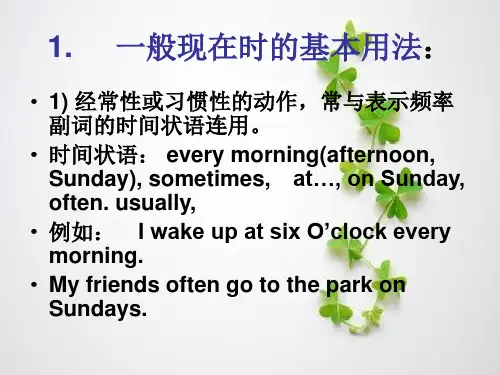
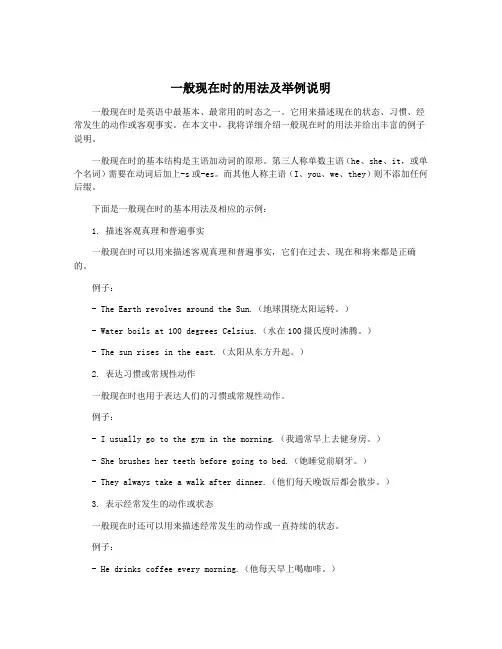
一般现在时的用法及举例说明一般现在时是英语中最基本、最常用的时态之一。
它用来描述现在的状态、习惯、经常发生的动作或客观事实。
在本文中,我将详细介绍一般现在时的用法并给出丰富的例子说明。
一般现在时的基本结构是主语加动词的原形。
第三人称单数主语(he、she、it,或单个名词)需要在动词后加上-s或-es。
而其他人称主语(I、you、we、they)则不添加任何后缀。
下面是一般现在时的基本用法及相应的示例:1. 描述客观真理和普遍事实一般现在时可以用来描述客观真理和普遍事实,它们在过去、现在和将来都是正确的。
例子:- The Earth revolves around the Sun.(地球围绕太阳运转。
)- Water boils at 100 degrees Celsius.(水在100摄氏度时沸腾。
)- The sun rises in the east.(太阳从东方升起。
)2. 表达习惯或常规性动作一般现在时也用于表达人们的习惯或常规性动作。
例子:- I usually go to the gym in the morning.(我通常早上去健身房。
)- She brushes her teeth before going to bed.(她睡觉前刷牙。
)- They always take a walk after dinner.(他们每天晚饭后都会散步。
)3. 表示经常发生的动作或状态一般现在时还可以用来描述经常发生的动作或一直持续的状态。
例子:- He drinks coffee every morning.(他每天早上喝咖啡。
)- They play tennis every weekend.(他们每个周末打网球。
)- The cat sits on the windowsill.(猫坐在窗台上。
)4. 表达现在时刻正在发生的动作一般现在时也可以用来描述现在时刻正在发生的动作。
例子:- I am writing an essay right now.(我现在正在写一篇文章。
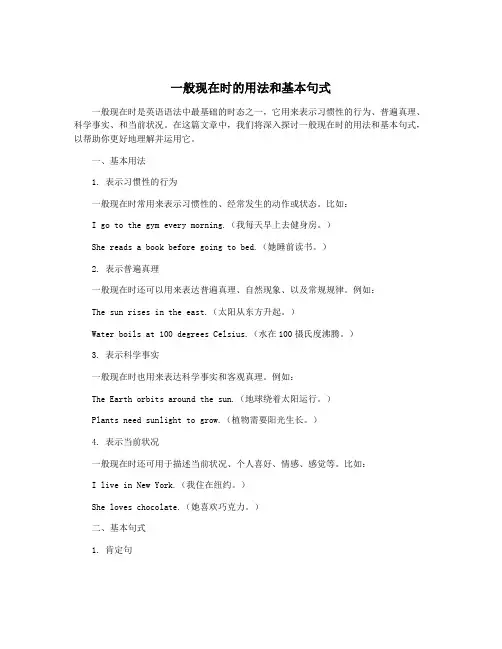
一般现在时的用法和基本句式一般现在时是英语语法中最基础的时态之一,它用来表示习惯性的行为、普遍真理、科学事实、和当前状况。
在这篇文章中,我们将深入探讨一般现在时的用法和基本句式,以帮助你更好地理解并运用它。
一、基本用法1. 表示习惯性的行为一般现在时常用来表示习惯性的、经常发生的动作或状态。
比如:I go to the gym every morning.(我每天早上去健身房。
)She reads a book before going to bed.(她睡前读书。
)2. 表示普遍真理一般现在时还可以用来表达普遍真理、自然现象、以及常规规律。
例如:The sun rises in the east.(太阳从东方升起。
)Water boils at 100 degrees Celsius.(水在100摄氏度沸腾。
)3. 表示科学事实一般现在时也用来表达科学事实和客观真理。
例如:The Earth orbits around the sun.(地球绕着太阳运行。
)Plants need sunlight to grow.(植物需要阳光生长。
)4. 表示当前状况一般现在时还可用于描述当前状况、个人喜好、情感、感觉等。
比如:I live in New York.(我住在纽约。
)She loves chocolate.(她喜欢巧克力。
)二、基本句式1. 肯定句一般现在时的肯定句结构为:主语 + 动词原形(或动词第三人称单数形式)+ 其他。
例如:He eats breakfast at 7 o’clock.(他7点吃早餐。
)They play basketball every weekend.(他们每个周末打篮球。
)2. 否定句一般现在时的否定句结构为:主语 + 动词原形(或动词第三人称单数形式)+ not + 其他。
例如:She does not like spicy food.(她不喜欢辣食。
)I do not work on Sundays.(我周日不工作。
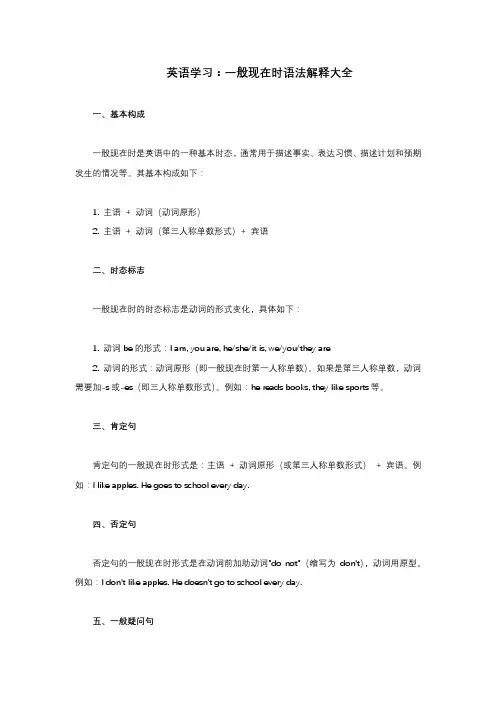
英语学习:一般现在时语法解释大全一、基本构成一般现在时是英语中的一种基本时态,通常用于描述事实、表达习惯、描述计划和预期发生的情况等。
其基本构成如下:1. 主语+ 动词(动词原形)2. 主语+ 动词(第三人称单数形式)+ 宾语二、时态标志一般现在时的时态标志是动词的形式变化,具体如下:1. 动词be的形式:I am, you are, he/she/it is, we/you/they are2. 动词的形式:动词原形(即一般现在时第一人称单数)。
如果是第三人称单数,动词需要加-s或-es(即三人称单数形式)。
例如:he reads books, they like sports等。
三、肯定句肯定句的一般现在时形式是:主语+ 动词原形(或第三人称单数形式)+ 宾语。
例如:I like apples. He goes to school every day.四、否定句否定句的一般现在时形式是在动词前加助动词"do not"(缩写为don't),动词用原型。
例如:I don't like apples. He doesn't go to school every day.五、一般疑问句一般疑问句的一般现在时形式是把助动词"do"或"does"放在句首,动词用原型。
例如:Do you like apples? Does he go to school every day?六、特殊疑问句特殊疑问句的一般现在时形式是以疑问词开头,后面接一般疑问句。
例如:What do you like? Where does he go to school?七、第三人称单数当主语是第三人称单数(he/she/it)时,动词需要变为第三人称单数形式,一般在动词后加-s或-es。
例如:he reads books, she goes to the park等。
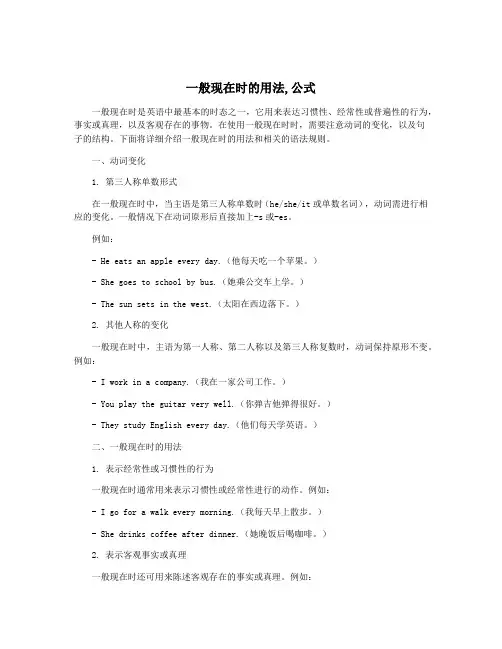
一般现在时的用法,公式一般现在时是英语中最基本的时态之一,它用来表达习惯性、经常性或普遍性的行为,事实或真理,以及客观存在的事物。
在使用一般现在时时,需要注意动词的变化,以及句子的结构。
下面将详细介绍一般现在时的用法和相关的语法规则。
一、动词变化1. 第三人称单数形式在一般现在时中,当主语是第三人称单数时(he/she/it或单数名词),动词需进行相应的变化。
一般情况下在动词原形后直接加上-s或-es。
例如:- He eats an apple every day.(他每天吃一个苹果。
)- She goes to school by bus.(她乘公交车上学。
)- The sun sets in the west.(太阳在西边落下。
)2. 其他人称的变化一般现在时中,主语为第一人称、第二人称以及第三人称复数时,动词保持原形不变。
例如:- I work in a company.(我在一家公司工作。
)- You play the guitar very well.(你弹吉他弹得很好。
)- They study English every day.(他们每天学英语。
)二、一般现在时的用法1. 表示经常性或习惯性的行为一般现在时通常用来表示习惯性或经常性进行的动作。
例如:- I go for a walk every morning.(我每天早上散步。
)- She drinks coffee after dinner.(她晚饭后喝咖啡。
)2. 表示客观事实或真理一般现在时还可用来陈述客观存在的事实或真理。
例如:- The earth revolves around the sun.(地球围绕太阳转。
)- Water boils at 100 degrees Celsius.(水在摄氏100度沸腾。
)3. 描述长期现象一般现在时也可用来描述长期存在的现象。
例如:- She lives in London.(她住在伦敦。
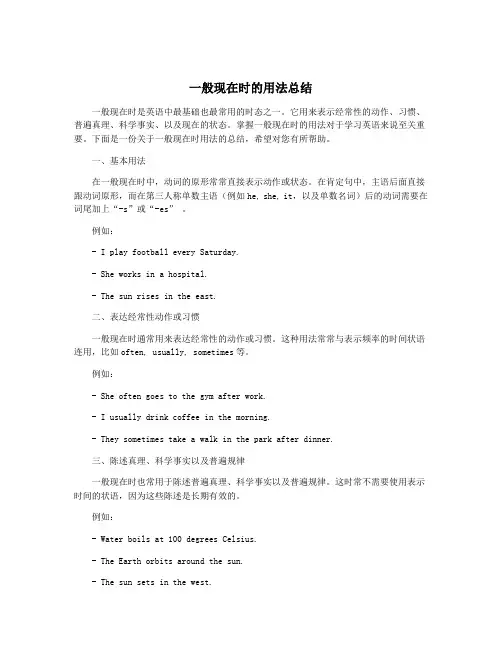
一般现在时的用法总结一般现在时是英语中最基础也最常用的时态之一。
它用来表示经常性的动作、习惯、普遍真理、科学事实、以及现在的状态。
掌握一般现在时的用法对于学习英语来说至关重要。
下面是一份关于一般现在时用法的总结,希望对您有所帮助。
一、基本用法在一般现在时中,动词的原形常常直接表示动作或状态。
在肯定句中,主语后面直接跟动词原形,而在第三人称单数主语(例如he, she, it,以及单数名词)后的动词需要在词尾加上“-s”或“-es” 。
例如:- I play football every Saturday.- She works in a hospital.- The sun rises in the east.二、表达经常性动作或习惯一般现在时通常用来表达经常性的动作或习惯。
这种用法常常与表示频率的时间状语连用,比如often, usually, sometimes等。
例如:- She often goes to the gym after work.- I usually drink coffee in the morning.- They sometimes take a walk in the park after dinner.三、陈述真理、科学事实以及普遍规律一般现在时也常用于陈述普遍真理、科学事实以及普遍规律。
这时常不需要使用表示时间的状语,因为这些陈述是长期有效的。
例如:- Water boils at 100 degrees Celsius.- The Earth orbits around the sun.- The sun sets in the west.四、表示现在状态一般现在时还可以用来表示现在的状态或特征。
例如:- She looks tired.- I feel happy.- The food smells delicious.五、特殊情况下的动词变化在一般现在时中,有一些动词的变化需要格外注意。
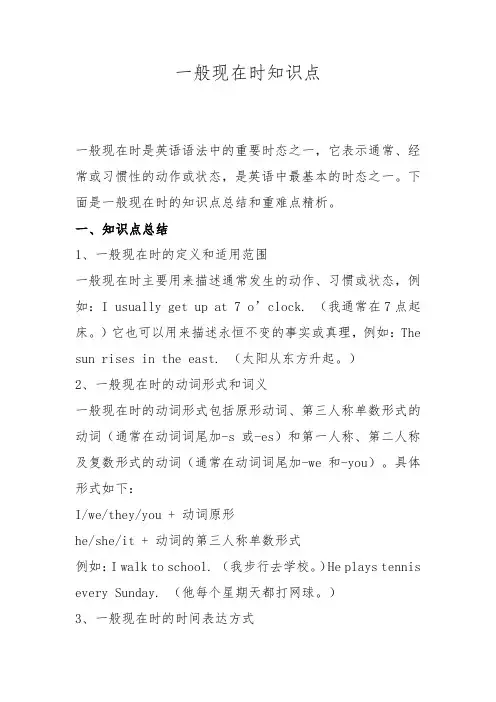
一般现在时知识点一般现在时是英语语法中的重要时态之一,它表示通常、经常或习惯性的动作或状态,是英语中最基本的时态之一。
下面是一般现在时的知识点总结和重难点精析。
一、知识点总结1、一般现在时的定义和适用范围一般现在时主要用来描述通常发生的动作、习惯或状态,例如:I usually get up at 7 o’clock. (我通常在7点起床。
)它也可以用来描述永恒不变的事实或真理,例如:The sun rises in the east. (太阳从东方升起。
)2、一般现在时的动词形式和词义一般现在时的动词形式包括原形动词、第三人称单数形式的动词(通常在动词词尾加-s或-es)和第一人称、第二人称及复数形式的动词(通常在动词词尾加-we和-you)。
具体形式如下:I/we/they/you + 动词原形he/she/it + 动词的第三人称单数形式例如:I walk to school. (我步行去学校。
)He plays tennis every Sunday. (他每个星期天都打网球。
)3、一般现在时的时间表达方式一般现在时的时间表达方式通常是通过时间状语来表示,例如:always(总是),usually(通常),often(经常),never(从不),sometimes(有时)等。
4、一般现在时的修辞手法修辞手法主要是通过语言表达方式来强调某种语气或情感,例如:使用情态动词can、may、must等来表达某种可能性或必要性,或者使用程度副词如completely(完全地)、absolutely(绝对地)等来强调某种程度。
二、重难点精析1、一般现在时与现在进行时的区别现在进行时表示正在进行的动作或状态,而一般现在时表示通常或习惯性的动作或状态。
例如:I am studying now. (我现在正在学习。
)I usually study in the evening. (我通常在晚上学习。
)2、一般现在时与将来完成时的联系将来完成时表示将来某个时间已经完成的动作或状态,而一般现在时表示现在或习惯性的动作或状态。
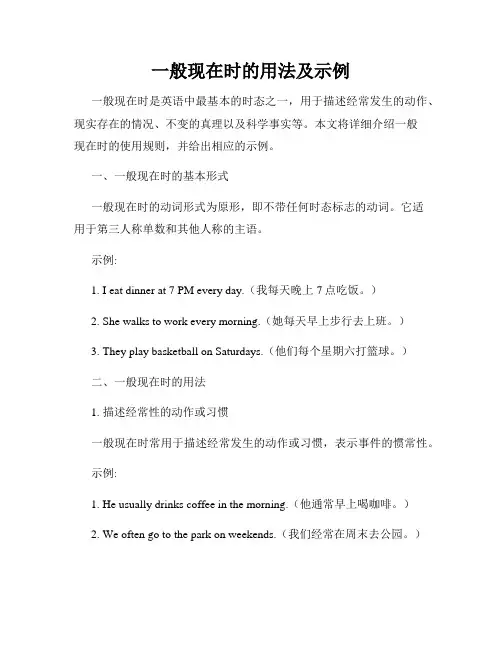
一般现在时的用法及示例一般现在时是英语中最基本的时态之一,用于描述经常发生的动作、现实存在的情况、不变的真理以及科学事实等。
本文将详细介绍一般现在时的使用规则,并给出相应的示例。
一、一般现在时的基本形式一般现在时的动词形式为原形,即不带任何时态标志的动词。
它适用于第三人称单数和其他人称的主语。
示例:1. I eat dinner at 7 PM every day.(我每天晚上7点吃饭。
)2. She walks to work every morning.(她每天早上步行去上班。
)3. They play basketball on Saturdays.(他们每个星期六打篮球。
)二、一般现在时的用法1. 描述经常性的动作或习惯一般现在时常用于描述经常发生的动作或习惯,表示事件的惯常性。
示例:1. He usually drinks coffee in the morning.(他通常早上喝咖啡。
)2. We often go to the park on weekends.(我们经常在周末去公园。
)3. Mary always reads books before going to bed.(玛丽睡觉前总是看书。
)2. 表示现实存在的情况一般现在时还用于描述现实存在的情况,即事实或状态。
示例:1. The sun rises in the east.(太阳从东方升起。
)2. Water boils at 100 degrees Celsius.(水在100摄氏度沸腾。
)3. Dogs are loyal animals.(狗是忠诚的动物。
)3. 表示客观真理或普遍事实一般现在时还可以用于表达客观真理或普遍事实,即通常情况下普遍适用的陈述句。
示例:1. The Earth revolves around the sun.(地球绕太阳旋转。
)2. Plants need sunlight to grow.(植物需要阳光才能生长。
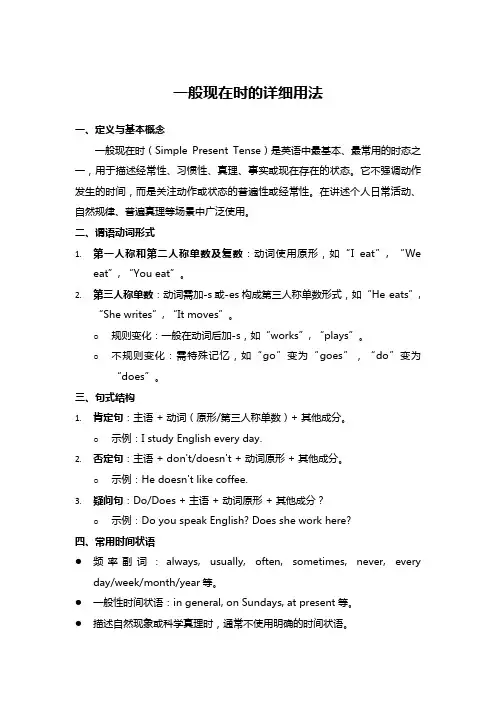
一般现在时的详细用法一、定义与基本概念一般现在时(Simple Present Tense)是英语中最基本、最常用的时态之一,用于描述经常性、习惯性、真理、事实或现在存在的状态。
它不强调动作发生的时间,而是关注动作或状态的普遍性或经常性。
在讲述个人日常活动、自然规律、普遍真理等场景中广泛使用。
二、谓语动词形式1.第一人称和第二人称单数及复数:动词使用原形,如“I eat”, “Weeat”, “You eat”。
2.第三人称单数:动词需加-s或-es构成第三人称单数形式,如“He eats”,“She writes”, “It moves”。
o规则变化:一般在动词后加-s,如“works”, “plays”。
o不规则变化:需特殊记忆,如“go”变为“goes”,“do”变为“does”。
三、句式结构1.肯定句:主语 + 动词(原形/第三人称单数)+ 其他成分。
o示例:I study English every day.2.否定句:主语 + don't/doesn't + 动词原形 + 其他成分。
o示例:He doesn't like coffee.3.疑问句:Do/Does + 主语 + 动词原形 + 其他成分?o示例:Do you speak English? Does she work here?四、常用时间状语●频率副词:always, usually, often, sometimes, never, everyday/week/month/year等。
●一般性时间状语:in general, on Sundays, at present等。
●描述自然现象或科学真理时,通常不使用明确的时间状语。
五、特殊用法1.表示将来确定会发生的事情:在时间状语从句或条件状语从句中,主句使用一般将来时,从句则用一般现在时代替一般将来时。
o示例:If it rains tomorrow, we won't go to the park.2.描述心理感觉或状态:如“I see”, “I feel”等,表示当前的心理感受或状态。

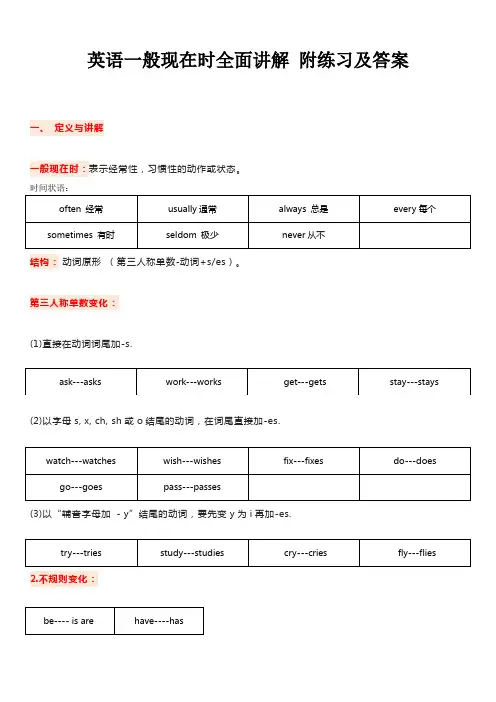
英语一般现在时全面讲解附练习及答案一、定义与讲解一般现在时:表示经常性,习惯性的动作或状态。
结构:动词原形(第三人称单数-动词+s/es)。
第三人称单数变化:(1)直接在动词词尾加-s.(2)以字母s, x, ch, sh或o结尾的动词,在词尾直接加-es.(3)以“辅音字母加- y”结尾的动词,要先变y为i再加-es.2.不规则变化:二、一般现在时用法1. 表示经常性,习惯性,永久性的动作或存在的状态.通常与副词sometimes, often, usually, always, every day (year, month ), once (twice, three times) a day,等时间状语连用。
2. 表示客观真理,科学原理,自然现象,等客观事实或格言,谚语等。
三、一般现在时的句子转换:(1)当句子中有be动词或情态动词时,则把be动词或情态动词(can,could等等)提到主语的前面变成疑问句;在be动词或情态动词后面加not变成否定句.(2)当句子中即没有be动词,也没有情态动词时,则在主语前加助动词do (you,以及复数), does(单数she,he,it)变成问句;在主语后谓语动词前加助动词don’t(I,you,以及复数), doesn’t(单数she,he,it)变成否定句,助动词后的动词要变成动词原形。
名师解析1.________ you often ________ tea?A.Do;drinks B.Does;drink C.Do;drink分析:你经常喝茶吗?根据often可知句子为一般现在时,主语为you,用助动词Do提问,动词用原形,C 符合题意,故选C。
2.My legs .A.hurt B.hurts C.hurting分析:我的腿……。
A痛,动词原形;B痛,动词单三形式,主语是名词复数,谓语动词用原形,排除;C痛,现在分词,用于现在进行时,构成be doing,缺少be,排除。
一般现在时基本用法介绍一、一般现在时的意义1.表示事物或人物的特征、状态。
如:The sky is blue.天空是蓝色的。
He is tall.他很高。
2.表示经常性或习惯性的动作(常与usually,always ,sometimes,often,every ...连用)。
如:I get up at six every day.我每天六点起床。
My mother goes hiking every weekend.我妈妈每个周末都要去远足。
He often plays football on the weekend.他周末常常踢足球。
3.表示客观事实,普遍真理。
如:The earth goes around the sun.地球绕着太阳转。
The trees turn green in spring.春天树子要绿。
二、一般现在时的谓语动词形式1.be动词:主语+be(am,is,are)如:I am a boy.我是一个男孩。
2.情态动词+动词原形如:He can fly kites .他会放风筝。
My sister can sing English songs very well.我妹妹唱英文歌曲唱得很好。
3.实义动词(又称行为动词):在一般现在时中,实义动词作谓语动词有两种形式:动词原形和动词的单数第三人称形式(1)动词原形:当主语不是单数第三人称时,谓语动词用原形。
如:We study English.我们学习英语。
I like singing.我喜欢唱歌。
(2)当主语是单数第三人称(he,she ,it以及可以用he, she ,it 代替的名词、名词短语,如Amy,Zhang Peng,my sister,John’s pen pal等)时,谓语动词要使用单数第三人称形式(简称“单三式”或“单三现”。
如:He likes dancing.他喜欢跳舞。
My sister usually goes shopping on the weekend.我妹妹周末常常去购物。
一般现在时的五种基本用法详解一、表示客观事实一般现在时最基本的用法是表示客观事实,即描述我们日常生活中经常发生的事情、存在的状态或者普遍的真理。
例如:1. The sun rises in the east.(太阳从东方升起。
)2. Water boils at 100 degrees Celsius.(水在100摄氏度煮沸。
)3. Cats like to play with yarn.(猫喜欢玩线团。
)二、表示经常性的动作或习惯一般现在时还用于表示经常性的动作或习惯,即反复发生、一贯存在的动作或习惯。
例如:1. He usually drinks coffee in the morning.(他通常早上喝咖啡。
)2. They go for a walk every evening after dinner.(他们每天晚饭后都会散步。
)三、表示现阶段的状态一般现在时还可以表示目前的状态或情况,即用于描述现阶段的情况或存在的状态。
例如:1. I am currently studying at university.(我目前正在大学学习。
)2. The company is expanding its business in Asia.(该公司正在亚洲扩展业务。
)四、表示固定的时间表或日程安排一般现在时还可用于表示固定的时间表或日程安排,通常与表示时间的副词或短语连用。
例如:1. The train leaves at 8 o'clock every morning.(火车每天早上8点离开。
)2. The store opens at 9 am and closes at 6 pm.(商店上午9点开门,下午6点关门。
)五、表示演绎、描绘或评论一般现在时有时还用于演绎、描绘或评论一段已经发生的情节或故事。
例如:1. He walks through the door, looks around and greets everyone.(他走进门,环顾四周,向每个人打招呼。
英语一般现在时动词用法全解英语中的动词时态非常重要,而一般现在时 (Simple Present Tense)是最基本的时态之一。
我们来全面解析一下英语一般现在时动词的用法。
一、动词的基本形式在一般现在时中,动词使用原形,即基本形式,不加任何变化。
例如:1. I study English every day. (我每天学习英语。
)2. They play football on weekends. (他们周末踢足球。
)3. She works in a hospital. (她在一家医院工作。
)二、第三人称单数形式在第三人称单数形式中,动词要加上-s 或 -es 结尾。
其中大部分动词只需加上 -s,而以下情况例外:1. 以辅音字母+ y 结尾的动词,在第三人称单数形式中,变为-ies。
例如:- study → studies (学习)- fly → flies (飞)2. 以 -s, -sh, -ch, -x, -o 结尾的动词,在第三人称单数形式中,变为 -es。
例如:- miss → misses (错过)- watch → w atches (观看)请注意以下动词特殊变化形式:1. have → has2. do → does3. go → goes4. can → can(无变化)5. want → wants例句:1. He reads a book every night. (他每晚读一本书。
)2. She teaches English at a school. (她在一所学校教英语。
)3. My mother cooks delicious meals. (我的妈妈做的饭菜很好吃。
)三、动词用于否定句和疑问句在否定句和疑问句中,需要使用助动词 do 或 does。
同时需要注意下列规则:1. 在否定句中,将 do not 或 does not 放在动词前面。
例如:- I do not study French. (我不学法语。
一般现在时解释及应用一般现在时是英语中最基本的时态之一,用来描述现在发生的动作、存在的状态或者经常性的事实。
在一般现在时中,动词的变化较为简单,一般在第三人称单数时才会有变化。
此外,一般现在时还可以用来表达一般的真理、习惯、经验和现实等。
一般现在时的形态:1.肯定句:主语+动词原形(即动词的第三人称单数形式)+其他成分例如:- He works in a bank. (他在一家银行工作。
)- The dog barks loudly. (那只狗很吵。
)2.否定句:主语+ do/does not +动词原形+其他成分例如:- I do not like coffee. (我不喜欢咖啡。
)- She does not play basketball. (她不打篮球。
)3.一般疑问句:Do/Does +主语+动词原形+其他成分?例如:- Do you like chocolate? (你喜欢巧克力吗?)- Does he teach English? (他教英语吗?)4.特殊疑问句:疑问代词/副词+ do/does +主语+动词原形+其他成分?例如:- What does she do in her free time? (她空闲时间做什么?)- Where do you live? (你住在哪里?)一般现在时的用法:1.描述现在的动作或状态:一般现在时可用来描述现在正在发生的动作或者表达当前的状态。
例如:- She watches TV every evening. (她每天晚上看电视。
)- The sun rises in the east. (太阳从东方升起。
)- I am a student. (我是一名学生。
)2.表示习惯、经验或真理:一般现在时也可以用来表达经常性的行为、习惯、经验或一般的真理。
例如:- They always go for a walk after dinner. (他们晚饭后总是去散步。
千里之行,始于足下。
小学英语语法-一般现在时详细讲解一般现在时(Simple Present Tense)是英语中最常用的时态之一,表示经常性的行为、习惯、真理、现在的状态等。
以下是关于一般现在时的详细讲解:1. 用法:- 表示客观真理或事实:The sun rises in the east. (太阳从东方升起。
)- 表示经常性的行为或习惯:He reads books every night. (他每晚都看书。
)- 表示现阶段的状态或现象:She speaks three languages. (她会说三种语言。
)2. 构成:- 肯定句:主语 + 动词原形(第三人称单数形式在动词后加-s或-es)+ 其他。
- 否定句:主语 + do / does not + 动词原形 + 其他。
- 疑问句:Do / Does + 主语 + 动词原形 + 其他?3. 第三人称单数形式的规则:在一般现在时中,第三人称单数形式需要在动词后加-s或-es。
- 如果动词以-s, -sh, -ch, -x, -o结尾,加-es。
如:goes, watches。
- 如果动词以辅音字母+y结尾,将y改为i,再加-es。
如:studies。
- 其他情况直接加-s。
如:reads, eats。
4. 句型转换:第1页/共2页锲而不舍,金石可镂。
- 肯定句变为否定句:将动词前的助动词do / does 变为 do not / does not。
如:I love cats.(肯定句)→ I do not love cats.(否定句) - 肯定句变为疑问句:将助动词do / does提到主语之前。
如:Youlike pizza.(肯定句)→ Do you like pizza?(疑问句)- 否定句变为肯定句:将助动词do / does 去掉。
如:He doesn'tplay tennis.(否定句)→ He plays tennis.(肯定句)- 否定句变为疑问句:将助动词do / does提到主语之前,并去掉not。
一般现在时
The Present Simple Tense (also called the Simple Present Tense) Simple present tense with 'be':
The verb ‘be’ is different from the other verbs in this tense. Let's look at ‘be’ first: Here’s the positive form (positive means a normal sentence, not a negative or a question. This is sometimes called ‘affirmative’):
For example:
•I’m Scottish.
•She’s hungry.
•They’re always late.
Next, here's the negative. It's very easy. You only add ‘not’:
For example:
•I’m not cold.
•He isn’t from Spain.
•We aren’t at home.
Here's the 'yes / no' question form:
For example:
•Am I next in the queue?
•Are you from Tokyo?
•Is he at the library at the moment?
If you'd like to make a ‘wh’ question, you just put the question word at the front:
For example:
•Where are you from?
•Who is that girl?
•Why are they still at work?
Present simple tense with other verbs:
With all other verbs, we make the present simple in the same way.
The positive is really easy. It's just the verb, with an extra ‘s’ if the subject is ‘he’,
‘she’, or ‘it’. Let's take the verb ‘play’ as an example:
For example:
•I play tennis every week.
•He likes chocolate.
•They usually go to the cinema on Fridays.
Don't forget the ‘s’! Even really advanced students do this!
For a few verbs, there is a spelling change with ‘he’, ‘she’ and‘it’ before the ‘s’. For example, ‘study’ becomes ‘studies’. (See spelling changes PDF for more information). .
There are also few verbs which are irregular in the present simple:
•'have' becomes 'has'
•'do' becomes 'does'
•'go' becomes 'goes'
To make the negative form, you need to use ‘do not’ (don't) or ‘ does not’ (doesn't):
For example:
•You don’t study very much.
•Julie doesn’t like sport.
•We don’t live in London.
We use ‘do’ or ‘does’ before the subject to make the 'yes / no' question:
For example:
•Do you work in an office?
•Does John play cricket every weekend?
•Do they like travelling?
Just like with 'be', if you'd like to make a ‘wh’ question, you put the question word at the front:
For example:
•Where do you live?
•What does she like to eat?
•Why do they work so hard?。